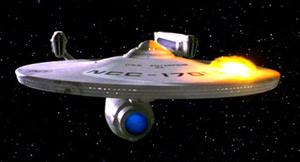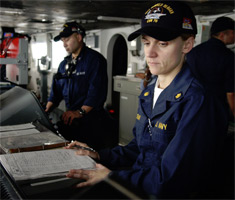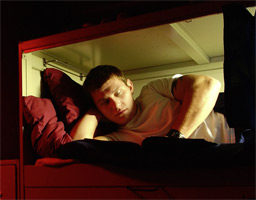How many people do you need to run a starship? I see stories where it’s a crew of hundreds, while others manage with just one. It’s not that either is wrong. I think it simply depends on the rules of the story’s universe and the purpose of the ship.
At one end, I think about the one-man ships of Larry Niven or Jack McDevitt. These typically have a fair amount of computer automation. McDevitt’s ships in particular have an AI who is perfectly capable of taking the ship through all its maneuvers and activities, leaving the “pilot” as little more than a bossy passenger.
Even taking a more active hand, the single crewman usually only has to be alert and on duty for key transitions such as sub-light maneuvering thrusts or transitions into and out of the FTL-drive of choice. As long as nothing else goes wrong, this one crewman has a lot of time to kill. Then again, if something does go wrong, he has to be the one-man repair crew, and in many cases, his options are limited to sending out a distress call for a rescue ship.
At the other end we have giant warships like the Enterprise or the Galactica. They seem to have less computer automation, so they require more people spread around the ship pushing the right buttons at the right time. They also have extra functions that those one-man ships do not, ranging from combat to exploration, so they need extra crew to deal with those things. And as the button pushers and red-shirts add up, you need more officers for command and control.
 Furthermore, a lot more can break on a warship than on a small passenger ship. In fact, warships frequently seek out situations where things break spectacularly. No longer is one lonely crewman replacing a leaky fuel line. Instead, it’s a team of thirty repairing a hull breach and welding the engine mounts back into place.
Furthermore, a lot more can break on a warship than on a small passenger ship. In fact, warships frequently seek out situations where things break spectacularly. No longer is one lonely crewman replacing a leaky fuel line. Instead, it’s a team of thirty repairing a hull breach and welding the engine mounts back into place.
But what about the in-between cases?
One of the reasons I really enjoyed Nathan Lowell’s Solar Clipper series (start with Quarter Share) was that he paid attention to all the boring little details of keeping a ship up and running. From his books (and some of the ones I’m working on), I’ve realized that in addition to the obvious jobs of sitting in the captain’s chair and locking phasers on target, there are three main things that occupy the bulk of the crew: standing watch, doing maintenance, and sleeping.
 Standing watch is probably the most boring thing you can imagine, because you’re essentially waiting around all day for something to go wrong. This looks like a prime candidate for computer automation. After all, the computer can wait 24/7 for something to happen, and it doesn’t need a chair. Still, it’s important to have an actual person there, because when something does go wrong – and sooner or later, it will – then you want to have a live body there, paying attention, and ready to take action. There are quite a few things that could wait five or ten minutes for you to wake up and get dressed, but the matter/anti-matter injection valves probably can’t wait.
Standing watch is probably the most boring thing you can imagine, because you’re essentially waiting around all day for something to go wrong. This looks like a prime candidate for computer automation. After all, the computer can wait 24/7 for something to happen, and it doesn’t need a chair. Still, it’s important to have an actual person there, because when something does go wrong – and sooner or later, it will – then you want to have a live body there, paying attention, and ready to take action. There are quite a few things that could wait five or ten minutes for you to wake up and get dressed, but the matter/anti-matter injection valves probably can’t wait.
Maintenance is almost the opposite. You’re not waiting for anything to go wrong. You’re fixing it or replacing it before it can. The environmental team is changing out the CO2 scrubbers, and the engineers are realigning the polarity on… well, you know how those engineers can be about polarity. Some maintenance is hard to do when you’re underway, but if the ship has any kind of redundant systems, you can be sure that they’ll be falling back to them on occasion both as a test and for a chance to do maintenance on the primary system.
 And sleep? Sleep is kind of a placeholder for all the drawbacks to those lazy organic crews. They keep wanting to sleep, and that’s on top of wanting to eat food several times a day. I figure about the hardest you can push someone is twelve-hour shifts, seven days a week. We’re not talking about heavy physical labor in the cotton field, but keeping alert for twelve hours is a challenge. You’d be a lot better off with eight-hour shifts and enough crew to allow other downtime. Toss in a galley, maybe a small gym or some recreation, and the crew to manage all that. Pretty soon your little eight-man ship is ballooning up to twenty or more.
And sleep? Sleep is kind of a placeholder for all the drawbacks to those lazy organic crews. They keep wanting to sleep, and that’s on top of wanting to eat food several times a day. I figure about the hardest you can push someone is twelve-hour shifts, seven days a week. We’re not talking about heavy physical labor in the cotton field, but keeping alert for twelve hours is a challenge. You’d be a lot better off with eight-hour shifts and enough crew to allow other downtime. Toss in a galley, maybe a small gym or some recreation, and the crew to manage all that. Pretty soon your little eight-man ship is ballooning up to twenty or more.
I screwed up on this in my first book Beneath the Sky, in that the merchant ship Jinley is crewed by only four or five, but I never delved into the day-to-day shipboard life in that story. In the upcoming Ships of my Fathers and Debts of my Fathers, I thought about it a lot more and concluded that a merchant ship that size really should have six or seven crew: two navigators, two engineers, an environmental specialist, a cook, and a captain who can hopefully jump in to fill any of those slots in a pinch. That’s largely because the rules of this particular universe makes FTL a hands-on task, dealing with the shifting tachyon winds and managing the ephemeral sails that grab that wind. Twelve-hour shifts are a bitch, but bigger ships with more crew provide an easier life, with more downtime, better rested crews, and more redundancy.
So, before you head out on that long solo flight, give some thought to who is going to fix the toilet when you’re laid up with flu. Do you have a robot helper? A first officer in cryo-sleep? The 800-number for deep space Roto-Router?
